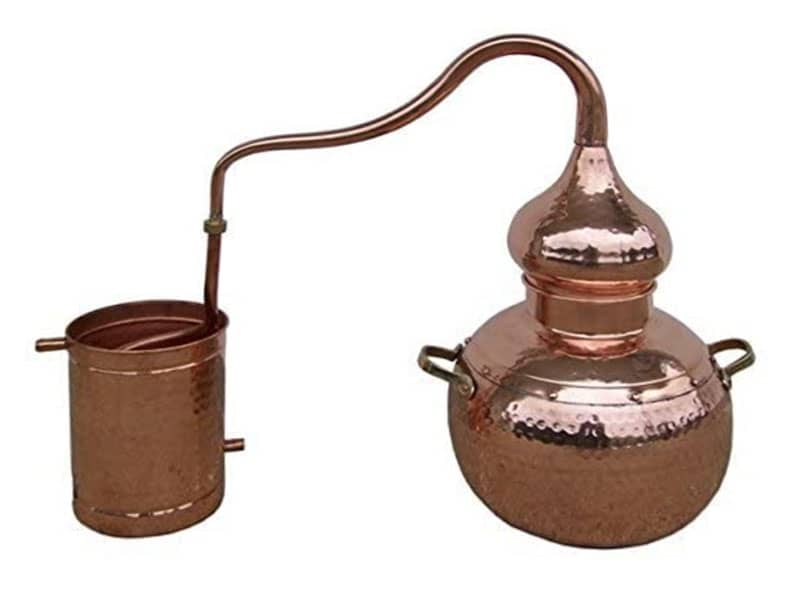George Saintsbury (1845-1933) was an English writer, journalist and literary critic expert in French and English literature but also a famous wine expert, well known for his work Notes on a Cellar-Book (1920) in which he collected detailed notes of all the wines he had tasted from 1894 to 1915, offering a very personal vision of the whole oenological panorama of his time.
That the fermentation of grape must produces wine is a well-known fact; however, other beverages full of aromatic nuances and with very different intensities can be prepared from grape juice. It was the Arabs who introduced the concept of distilling wine to extract its essence, al-ghool, evil spirit, which they used mainly as a disinfectant and in medicine, which in Latin came to be called aqua ardens, eau-de-vie. It is probable that it was used to macerate medicinal herbs giving origin to the cordiales from which the whole group of liquors generically called ‘digestives’ would later derive. In this sense, it was the Christian monks who developed the technique of distillation to produce spirits.
Some of the most famous are Brandy, from the Dutch “brandewijn” meaning burnt wine. The production by distillation of young wine was made in Spain for export to Holland; the brandy obtained (called holandas), with an alcoholic concentration between 35 and 60%, was stored in oak casks, where it oxidized and obtained its characteristic dark golden color. Within this group we find specific denominations of origin such as Cognac, (north of Bordeaux and made from white grapes of the ugni blanc variety), or Armagnac (in the Gascony region).
Another type of distillate would be the one made from skins and pips (generically pomace distillates), which would form the group of Grappas (Italy) and Orujos (Spain). Its origin would be in the use of the remaining bagasse from the grape pressing. They are powerful and dry distillates, of high alcohol content, very popular in Italy and Spain, which are drunk cold after a meal, or mixed with coffee (caffè corretto or carajillo).
When these same distillates are flavored with anise seeds, we enter the Eastern Mediterranean: Arak (the national drink of Lebanon, and highly appreciated in Jordan and Syria), Raki (Turkey) and Ouzo (Greece). All of them are liqueurs made by double distillation to which anise seeds are added for flavoring. They are drunk mixed with water or ice, which makes them take on a whitish color of intense turbidity.
If, instead of digestives, we are looking for a liqueur that stimulates the taste, we are talking about aperitifs. Among them we find the well-known Vermouth, a mixture of muscatel wine, sweetened with caramel, aromatic herbs and spices; or the Quina, with a bitter taste due to the bark of quina, a South American shrub, which is drunk with ice and soda. Special mention should be made of Pisco (Chile and Peru) and Singani (Bolivia), a distillate of aromatic grapes (mainly Muscatel) and non-aromatic grapes which have in common their high sugar content, and which are drunk in the form of mixed drinks (Pisco Sour, with lemon, sugar and egg; and Chuflay, with ginger ale).

Wine pills


George Saintsbury (1845-1933) was an English writer, journalist and literary critic expert in French and English literature but also a famous wine expert, well known for his work Notes on a Cellar-Book (1920) in which he collected detailed notes of all the wines he had tasted from 1894 to 1915, offering a very personal vision of the whole oenological panorama of his time.
That the fermentation of grape must produces wine is a well-known fact; however, other beverages full of aromatic nuances and with very different intensities can be prepared from grape juice. It was the Arabs who introduced the concept of distilling wine to extract its essence, al-ghool, evil spirit, which they used mainly as a disinfectant and in medicine, which in Latin came to be called aqua ardens, eau-de-vie. It is probable that it was used to macerate medicinal herbs giving origin to the cordiales from which the whole group of liquors generically called ‘digestives’ would later derive. In this sense, it was the Christian monks who developed the technique of distillation to produce spirits.
Some of the most famous are Brandy, from the Dutch “brandewijn” meaning burnt wine. The production by distillation of young wine was made in Spain for export to Holland; the brandy obtained (called holandas), with an alcoholic concentration between 35 and 60%, was stored in oak casks, where it oxidized and obtained its characteristic dark golden color. Within this group we find specific denominations of origin such as Cognac, (north of Bordeaux and made from white grapes of the ugni blanc variety), or Armagnac (in the Gascony region).
Another type of distillate would be the one made from skins and pips (generically pomace distillates), which would form the group of Grappas (Italy) and Orujos (Spain). Its origin would be in the use of the remaining bagasse from the grape pressing. They are powerful and dry distillates, of high alcohol content, very popular in Italy and Spain, which are drunk cold after a meal, or mixed with coffee (caffè corretto or carajillo).
When these same distillates are flavored with anise seeds, we enter the Eastern Mediterranean: Arak (the national drink of Lebanon, and highly appreciated in Jordan and Syria), Raki (Turkey) and Ouzo (Greece). All of them are liqueurs made by double distillation to which anise seeds are added for flavoring. They are drunk mixed with water or ice, which makes them take on a whitish color of intense turbidity.
If, instead of digestives, we are looking for a liqueur that stimulates the taste, we are talking about aperitifs. Among them we find the well-known Vermouth, a mixture of muscatel wine, sweetened with caramel, aromatic herbs and spices; or the Quina, with a bitter taste due to the bark of quina, a South American shrub, which is drunk with ice and soda. Special mention should be made of Pisco (Chile and Peru) and Singani (Bolivia), a distillate of aromatic grapes (mainly Muscatel) and non-aromatic grapes which have in common their high sugar content, and which are drunk in the form of mixed drinks (Pisco Sour, with lemon, sugar and egg; and Chuflay, with ginger ale).


Chilean pisco is made completely differently to Peruvian pisco, from the grapes used, to the distillation process, and, obviously, the geographic regions production is allowed.
Distillation is to bottle strength — this means that there is no diluting of the spirit, and results in a fuller flavour.
Chilean pisco can be distilled as many times as the producer deems fit, which raises the alcohol level of the spirit and unlike Peruvian pisco production, Chilean producers can dilute higher proof spirit to bottling strength.
Armagnac, is named for the French appellation in which it is made. There are three sub regions of Armagnac: Bas Armagnac, Tenareze, and Haut-Armagnac, with Bas Armagnac making the majority of production, as well as a spirit that is refined and elegant.
Yes, the Chileans and Peruvians still fight over who makes the best pisco — the only fact of the matter is pisco production began under the Spanish hundreds of years ago and before Chile and Peru came into being.
How Wine Is Made
Is wine made from grapes?
Wine is an alcoholic beverage made with the fermented juice of grapes. Technically, any fruit is capable of being used for wine (i.e., apples, cranberries, plums, etc.), but if it just says “wine” on the label, then it’s made with grapes. (By the way, wine grapes are different than table grapes ).
Do white grapes have sugar?
White grapes have approximately 16. 1 g of sugar per 100 g. White grapes, if consumed in a healthy way, can bring health benefits such as cancer prevention and favoring the health of hair, eyes and skin.
What type of grape is ice wine made from?
Ice wine may be made from any type of grape, although usually with Riesling or Vidal varietals. Ice wine is unique in that it can only be made when the vineyard freezes, which may happen in colder climates like Germany, Canada, and Switzerland.
Does wine contain alcohol?
It’s no secret, wine contains alcohol; it’s produced when yeasts consume the sugar in grape juice, turning it into alcohol and carbon dioxide. The alcohol percentage (referred to as alcohol by volume or ABV) varies from wine to wine. Wines on the low end contain around 7%.
